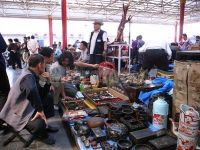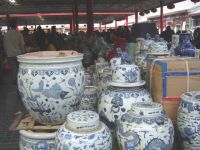Difference between revisions of "Panjiayuan Antique Market"
imported>Ciic |
imported>Ciic |
||
| Line 1: | Line 1: | ||
[[file: Panjiayuan Antiques Market.JPEG|thumb|200px|left|Panjiayuan Antiques Market]] | [[file: Panjiayuan Antiques Market.JPEG|thumb|200px|left|Panjiayuan Antiques Market]] | ||
| − | Situated west of Panjiayuan Bridge and south of the East Third Ring Road, the '''Panjiayuan Antiques Market''' is very accessible. The market deals mainly in antiques and arts and crafts. It also has the reputation of being the most inexpensive antiques market in Beijing, attracting foreign and domestic tourists. | + | Situated west of Panjiayuan Bridge and south of the East Third Ring Road, the '''Panjiayuan Antiques Market''' ('''潘家园旧货市场''') is very accessible. The market deals mainly in antiques and arts and crafts. It also has the reputation of being the most inexpensive antiques market in Beijing, attracting foreign and domestic tourists. |
Whether you want to sightsee, window-shop or buy collectors' items, there really is something for everyone. Even Hilary Clinton has famously shopped at Panjiayuan. | Whether you want to sightsee, window-shop or buy collectors' items, there really is something for everyone. Even Hilary Clinton has famously shopped at Panjiayuan. | ||
Latest revision as of 09:27, 6 September 2015
Situated west of Panjiayuan Bridge and south of the East Third Ring Road, the Panjiayuan Antiques Market (潘家园旧货市场) is very accessible. The market deals mainly in antiques and arts and crafts. It also has the reputation of being the most inexpensive antiques market in Beijing, attracting foreign and domestic tourists.
Whether you want to sightsee, window-shop or buy collectors' items, there really is something for everyone. Even Hilary Clinton has famously shopped at Panjiayuan.
With so many stalls selling similar items, this is a great place for bargain hunters. And although there are genuine articles to be found here, it is hard to tell the real deal from the fake, particularly if you aren't an expert.
Panjiayuan market covers an area of 4.85 hectares of land and accommodates over 3,000 stalls. It is the largest antiques market of its kind both in China and Asia.
It used to be a weekend-only market. But, after some refurbishment work, it is now open for business seven days a week. However, Saturdays and Sundays are still the best days to go.
Secondhand goods, arts and crafts and antiquities are the main transactions in the market. Also on offer are antique furniture imitations, what is known to the Chinese as the "Four Treasures of the Study" (writing brush, ink stick, paper and ink slab), old books and paintings, agate, jadeite, ceramics, ancient Chinese and foreign coins, bamboo and animal bone sculptures, leather puppets for shadow play and a wide range of Chinese opera masks.
Buddhist relics, costumes of ethnic minorities, apparels, "Cultural Revolution" (1966-76) articles and daily necessities can also be found here.
Traders from 24 provinces, municipalities and autonomous regions in China have stalls in the market, as do several ethnic minorities.
Panjiayuan market is truly a market packed with Chinese traditional culture.
Contents
History
Established initially as a flea market run by small traders in a Chaoyang hutong in 1980, it moved to its present location in 1995.
Beijingers in need of money in the 1980s were the first to take artworks from their family collections to the market to sell at the weekends. Such trading among individuals was forbidden at the time, and everyone kept a watchful eye out for police at all times.
In the early days, the open-air market would open for only a few hours every day. It was also called "ghost market," which means black market. The market for rare artwork developed fast. By 1990, the narrow hutong lanes were so crowded at the weekends that traders moved their "stalls" to a small patch of woods beside the Panjiayuan Bridge.
Hiding in the woods, hawkers spread out antiques in the shadows of boulders. Many of them were farmers from suburban Beijing or nearby provinces who sold items they had scraped together from their villages.
It was only in 1994 that trade in art and auctions were legalized. Countless art markets have sprouted around the city ever since.
Local authorities wanted to put an end to this business in the woods but failed. They then decided to build a proper market and have the hawkers pay rent.
And so the Panjiayuan Antiques Market came into being in 1995, the first legal antiques market in Beijing.
Stall space is so sought after here that many stall holders sub-let their stalls to others at daily rates much higher than theirs, making themselves a nice little profit without actually having to sell anything.
Layout
The market is divided into six parts:
In the western part of the market is an open-air area where large stone sculptures are sold out of trucks.
Next to this makeshift large sculptures section is a two-storied building that houses both modern and traditional furniture.
The vast middle section is a semi-covered area that forms the main part of the market. This section is open only at the weekends.
At the southernmost part is a narrow lane where secondhand books and ancient scrolls are sold. Cheaper less authentic versions of the same items can be found in some of the other stalls.
A range of other ancient arts and artifacts are on sale at stalls in the eastern part of the market in a big yard.
Highest-class antiques and more exquisite and more expensive handicrafts were sold in the small indoor stores, which surround the market in north and east.
And since the market opened, stalls in its semi-covered area of the middle part have been divided into four zones according to their items they have for sale.
Tips
The southeastern portion is called Zone One by Panjiayuan's veteran patrons. Here, you will find a dizzying array of Chinese paintings, calligraphic works as well as beads and jade.
What the new visitor needs to understand is that although the paintings and calligraphic works are usually handmade, they are mass-produced and therefore should not be very expensive.
Zone Two, or the northeastern section, boasts more beads, bronze vessels, ceramic vases and small wooden furniture.
This is also where one can find curios from the "Cultural Revolution" at a reasonable price.
Moving round to the southwestern part, or Zone Three, visitors are treated to a display of Chinese ethnic minority arts and crafts, trinkets, antiques and apparel. Many of these traders are from Tibet.
It has been said that one would find a more complete array of Tibetan cultural relics in Panjiayuan than in a Tibetan village.
Chinese ceramics take up most of the space in Zone Four, the northwestern section. And what the shopper needs to know is that most of them aren't antiques at all.
Fake ceramics makers are becoming very good at what they do, making it difficult for customers to tell the real and fake items apart. Some of the fake-making tricks they use include soaking bronzes in acid to rust them, and burying poor quality jade with dead poultry to give it that antiquated look.
But now, if asked most sellers confess what they sell are fake ones, which are just for decorating houses, and of course, more reasonable prices are given.
According to an established antique furniture dealer in Beijing, the easiest way to tell if a piece of furniture is really an antique is to lift it. An authentic old piece, generally made of hard wood, should be much heavier than a new one.
If you knock on the panels, different sounds are produced. The wood of a fake piece is generally thinner and emits a clearer and harsher sound.
Table surfaces and wardrobe doors, if truly antique, have a finer texture than most replicas, a sign of artistic talent.
Information
Location: 100m west of the Panjiayuan Bridge at the East Third Ring Road
Opening hours:8:30 - 18:30 from Monday to Friday;4:30 - 18:30 Saturday and Sunday

